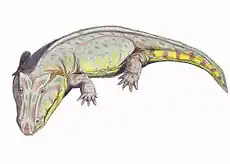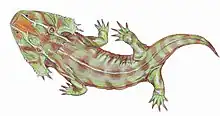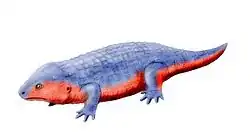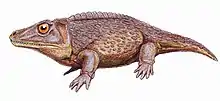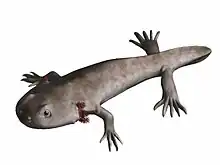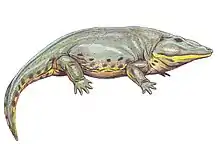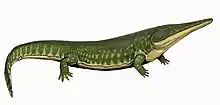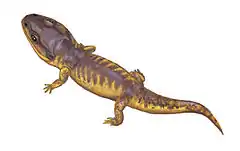| Lydekkerinidae Temporal range: Triassic, | |
|---|---|
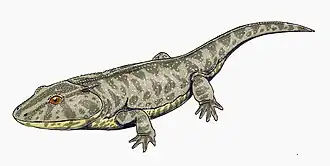 | |
| Life restoration of Lyddekerina huxleyi | |
| Scientific classification | |
| Domain: | Eukaryota |
| Kingdom: | Animalia |
| Phylum: | Chordata |
| Class: | Amphibia |
| Order: | †Temnospondyli |
| Suborder: | †Stereospondyli |
| Family: | †Lydekkerinidae Watson, 1919 |
| Synonyms | |
| |
Lydekkerinidae is a family of stereospondyl temnospondyls that lived in the Early Triassic period. During this time period, lydekkerinids were widely distributed, with putative remains reported from Russia, Greenland, India, South Africa, Madagascar, Australia, and Antarctica.[1][2][3][4][5][6] In contrast to most other stereospondyls, lydekkerinids were relatively small-bodied (most with skulls less than 10 cm in length). The type genus is Lydekkerina, the namesake of the family and the best-known lydekkerinid.
Description
The identification of features shared among lydekkerinids (synapomorphies) necessarily varies depending on which taxa are considered to belong to this group (see further in next section). In the most expansive concept, the family includes the eponymous Lydekkerina (and junior synonyms like 'Broomulus' and 'Limnoiketes'), Eolydekkerina from South Africa, Deltacephalus from Madagascar, Luzocephalus from Russia and Greenland (which includes the 'Aquiloniferus' of Bjerring (1999),[7] which is largely refuted by other workers), Chomatobatrachus from Australia, and indeterminate records from Antarctica and India ('Indobenthosuchus' and 'Cryobatrachus'). However, most previous workers have not considered all of these taxa to be true lydekkerinds;[4] in particular, the affinities of non-South African taxa have been challenged.
For example, Schoch & Milner (2000) considered all nominal lydekkerinids to belong to this family and listed featured like longitudinally oval, unpaired anterior palatal openings, with a pointed posterior end; and a broad and laterally extensive postorbital and prefrontal as synapomorphies.[3] Jeannot et al. (2006) considered most nominal lydekkerinids to indeed be lydekkerinids except for Deltacephalus and the indeterminate records.[4] They list features like a step-shaped contact between the nasal and prefrontal; indentation of anterolateral margin of interpterygoid vacuity; and a straight cheek margin when viewed in occipital view as synapomorphies. Conversely, Hewison (2007) did not consider Chomatobatrachus or Luzocephalus to be lydekkerinids and therefore listed a different set of features, such as palatine lacking denticles, but having an elongated postero-mesial process extending behind the most anterior ectopterygoid tooth; ectopterygoid lacking denticles; and septomaxillary with an ornamented roofing portion and an unornamented, plate- like intranarial portion.[8] Many of Hewison's features (of which there are more than two dozen) are not synapomorphies but rather are part of a unique combination of features or are symplesiomorphies, and they are not mutually exclusive with the autapomorphies of other workers.
Most recently, it has also been suggested that another small-bodied Early Triassic clade, Lapillopsidae, might nest within Lydekkerinidae, rendering the latter paraphyletic.[9] If so, this would introduce further uncertainty regarding diagnostic features of Lydekkerinidae.
Classification
Lydekkerinids are usually classified as basal stereospondyls. Schoch and Milner (2000) placed them in the clade Rhytidostea along with brachyopoids and rhytidosteids,[3] but this broader grouping is not widely employed today given the higher nesting position of brachyopoids and the uncertain position and monophyly of rhytidosteids.[10][11][12][13] Lydekkerinidae was also sometimes historically placed within the largely defunct Rhinesuchoidea[14][15] or within the still valid Capitosauroidea or Capitosauria,[2] but this too has not been supported by more recent work. Most phylogenetic studies that sampled only certain nominal lydekkerinids within a larger temnospondyl sample have found lydekkerinids to be paraphyletic or polyphyletic.[16][12][13][17][9] Furthermore, no complete phylogenetic analysis of all nominal lydekkerinids that would support monophyly in at least a restricted framework has been formally published.[18] Luzocephalus, which would be the largest of the lydekkerinids with a skull length over 15 cm,[19] has often been found to be more closely related to a family called Trematosauridae, such as in the study by Yates and Warren (2000). Chomatobatrachus has also been frequently dissociated from other nominal lydekkerinids.[2][8] Below is a cladogram from Yates and Warren (2000) showing the polyphyly:[10]
| Stereospondyli |
| ||||||||||||||||||||||||||||||||||||||||||||||||||||||||||||||||||||||||||||||||||||||||||||||||||||||||||||||||||
The phylogenetic analysis of Damiani (2001) resulted in a monophyletic Lydekkerinidae, although it was only weakly supported and included what is now recognized as the small-bodied Early Triassic capitosaur Edingerella madagascariensis. Below is a cladogram from that analysis:[20]
| Stereospondyli |
| |||||||||||||||||||||||||||||||||||||||||||||
Gallery
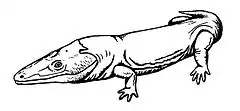
 Lyddekerina huxleyi, of the early Triassic of South Africa and Australia
Lyddekerina huxleyi, of the early Triassic of South Africa and Australia Cryobatrachus kitchingi, of the early Triassic of Antarctica
Cryobatrachus kitchingi, of the early Triassic of Antarctica
References
- ↑ Hewison, Robin H. (1996). "The skull of Deltacephalus whitei, a lydekkerinid temnospondyl amphibian from the Lower Triassic of Madagascar". Palaeontology. 39: 305–322.
- 1 2 3 Shishkin, Mikhail A.; Rubidge, Bruce S.; Kitching, James A. (1996-11-29). "A new lydekkerinid (Amphibia, Temnospondyli) from the lower Triassic of South Africa: implications for evolution of the early capitosauroid cranial pattern". Philosophical Transactions of the Royal Society of London. Series B: Biological Sciences. 351 (1347): 1635–1659. Bibcode:1996RSPTB.351.1635S. doi:10.1098/rstb.1996.0147. ISSN 0962-8436.
- 1 2 3 Schoch, Rainer R.; Milner, Andrew R. (2000). "3B. Stereospondyli". In P. Wellnhofer (ed.). Handbuch der Paläoherpetologie. Vol. 3B. Munich: Verlag Dr. Friedrich Pfeil. pp. 1–203.
- 1 2 3 Jeannot, A.M.; Damiani, R.; Rubidge, B.S. (2006). "Cranial anatomy of the Early Triassic stereospondyl Lydekkerina huxleyi (Tetrapoda: Temnospondyli) and the taxonomy of South African lydekkerinids". Journal of Vertebrate Paleontology. 26 (4): 822–838. doi:10.1671/0272-4634(2006)26[822:CAOTET]2.0.CO;2. ISSN 0272-4634. S2CID 86227485.
- ↑ WARREN, A. A.; DAMIANI, R.; YATES, A. M. (2006-09-04). "The South African stereospondyl Lydekkerina huxleyi (Tetrapoda, Temnospondyli) from the Lower Triassic of Australia". Geological Magazine. 143 (6): 877–886. Bibcode:2006GeoM..143..877W. doi:10.1017/s0016756806002524. ISSN 0016-7568. S2CID 13931179.
- ↑ Gee, Bryan M.; Makovicky, Peter J.; Sidor, Christian A. (2021-12-17). "Upside down: 'Cryobatrachus' and the lydekkerinid record from Antarctica". Journal of Paleontology. 96 (3): 658–683. doi:10.1017/jpa.2021.115. ISSN 0022-3360. S2CID 245312022.
- ↑ C., Bjerring, Hans (1999). Meddelelser om Grønland. a new amphibious tetrapod from the Greenlandic Eotriassic. OCLC 872235769.
{{cite book}}: CS1 maint: multiple names: authors list (link) - 1 2 Hewison, Robin H. (2007). The skull and mandible of the stereospondyl Lydekkerina huxleyi (Tetrapoda: Temnospondyli) from the Lower Triassic of South Africa, and a reappraisal of the family Lydekkerinidae, its origin, taxonomic relationships and phylogenetic importance. Somerset: Robin Hewison. pp. 1–80.
- 1 2 Eltink, Estevan; Schoch, Rainer R.; Langer, Max C. (2019-04-16). "Interrelationships, palaeobiogeography and early evolution of Stereospondylomorpha (Tetrapoda: Temnospondyli)". Journal of Iberian Geology. 45 (2): 251–267. doi:10.1007/s41513-019-00105-z. ISSN 1698-6180. S2CID 146595773.
- 1 2 Yates, A. M.; Warren, A. A. (2000). "The phylogeny of the 'higher' temnospondyls (Vertebrata: Choanata) and its implications for the monophyly and origins of the Stereospondyli". Zoological Journal of the Linnean Society. 128: 77–121. doi:10.1111/j.1096-3642.2000.tb00650.x.
- ↑ Warren, Anne; Marsicano, Claudia (2000-09-25). "A phylogeny of the Brachyopoidea (Temnospondyli, Stereospondyli)". Journal of Vertebrate Paleontology. 20 (3): 462–483. doi:10.1671/0272-4634(2000)020[0462:apotbt]2.0.co;2. hdl:11336/93649. ISSN 0272-4634. S2CID 86107783.
- 1 2 Dias-da-Silva, Sérgio; Marsicano, Claudia (2011). "Phylogenetic reappraisal of Rhytidosteidae (Stereospondyli: Trematosauria), temnospondyl amphibians from the Permian and Triassic". Journal of Systematic Palaeontology. 9 (2): 305–325. doi:10.1080/14772019.2010.492664. hdl:11336/68471. ISSN 1477-2019. S2CID 84569779.
- 1 2 Schoch, Rainer R. (2013). "The evolution of major temnospondyl clades: an inclusive phylogenetic analysis". Journal of Systematic Palaeontology. 11 (6): 673–705. doi:10.1080/14772019.2012.699006. ISSN 1477-2019. S2CID 83906628.
- ↑ Sherwood, Romer, Alfred (1947). Review of the labyrinthodontia. OCLC 253748351.
{{cite book}}: CS1 maint: multiple names: authors list (link) - ↑ Cosgriff, John W. (1984). "The temnospondyl labyrinthodonts of the earliest Triassic". Journal of Vertebrate Paleontology. 4 (1): 30–46. doi:10.1080/02724634.1984.10011984. ISSN 0272-4634.
- ↑ Ruta, Marcello; Pisani, Davide; Lloyd, Graeme T; Benton, Michael J (2007-12-22). "A supertree of Temnospondyli: cladogenetic patterns in the most species-rich group of early tetrapods". Proceedings of the Royal Society B: Biological Sciences. 274 (1629): 3087–3095. doi:10.1098/rspb.2007.1250. ISSN 0962-8452. PMC 2293949. PMID 17925278.
- ↑ Ruta, Marcello; Jeffery, Jonathan E.; Coates, Michael I. (2003-12-07). "A supertree of early tetrapods". Proceedings of the Royal Society of London. Series B: Biological Sciences. 270 (1532): 2507–2516. doi:10.1098/rspb.2003.2524. ISSN 0962-8452. PMC 1691537. PMID 14667343.
- ↑ Dias-da-Silva, Sergio; Hewison, Robin H. (2013). "Phylogenetic Analysis and Palaeobiogeography of the Pangaean Lower Triassic Lydekkerinidae (Temnospondyli, Stereospondyli)". 73rd Meeting of the Society of Vertebrate Paleontology Abstracts: 116 – via ResearchGate.
- ↑ Shishkin, Mikhail A. (1980). "The Luzocephalidae, a new Triassic labyrinthodont family". Paleontological Journal. 14: 88–101.
- ↑ Damiani, R. J. (2001). "A systematic revision and phylogenetic analysis of Triassic mastodonsauroids (Temnospondyli: Stereospondyli)". Zoological Journal of the Linnean Society. 133 (4): 379–482. doi:10.1111/j.1096-3642.2001.tb00635.x.
